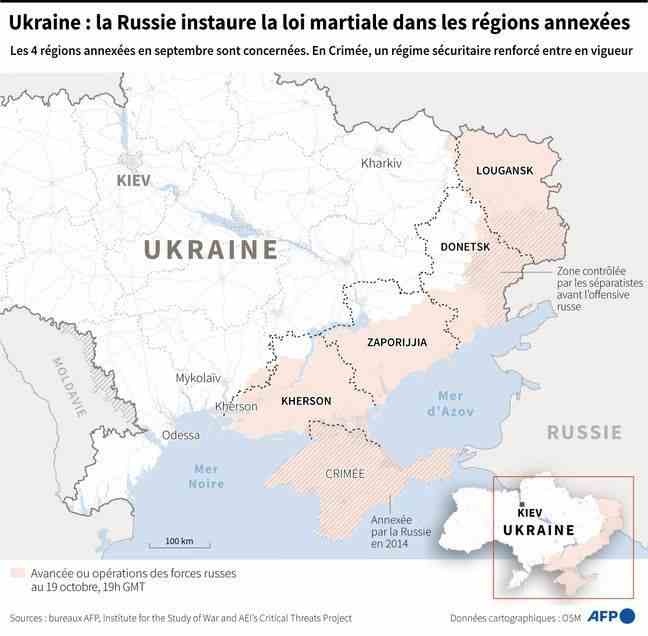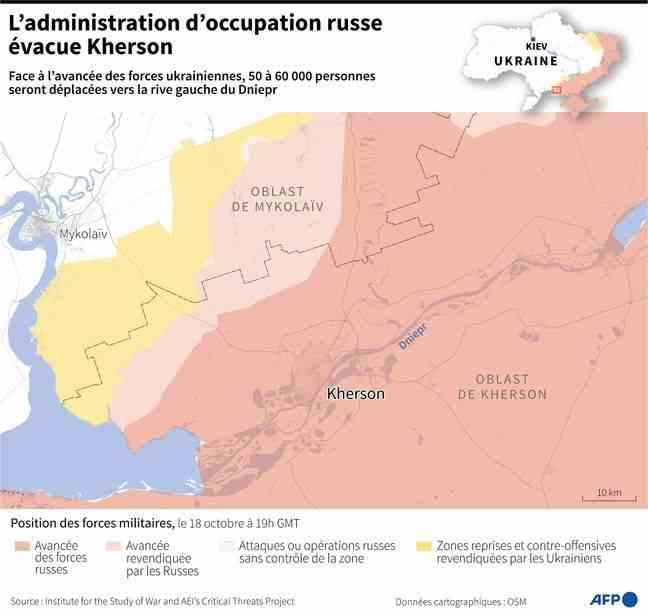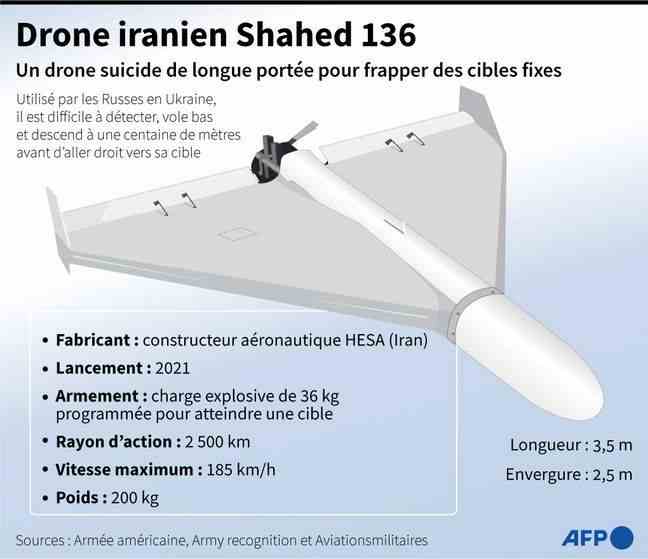Russian troops massed in the Kherson bridgehead, Ukrainians emboldened by their successes, civilians evacuated, martial law and Iranian drones… This week, the war in Ukraine took a new turn, Moscow, in retreat on all fronts, unleashing a salvo of strikes on critical Ukrainian infrastructure and opting for a scorched earth strategy to end its losing streak. Here is a point in four infographics on this new week of tensions, ending this Friday, the 240th day of conflict.
The strategy of “energy chaos”
After a series of defeats for its army on several fronts in Ukraine, Moscow has resolved on a brutal change of strategy to try to reverse this spiral of failure: massive strikes on Ukrainian power stations as the winter. Russian forces thus fired salvoes of cruise missiles and launched hundreds of Iranian-made suicide bomber drones at energy facilities, successfully crippling some 40% of Ukraine’s electricity grid.
After weeks of grumbling, Kremlin zealots suddenly smiled again “It’s impossible to survive when there’s no heat, no water, and no light,” MK Andrey Gurulev said this week .
At the same time, Ukrainian President Volodymyr Zelensky, speaking remotely before the European Council, said that Russia was turning Ukraine’s electricity grid into a “battlefield” to paralyze the country as winter approaches. For his part, Deputy Interior Minister Yevgeny Enin accused Moscow of causing “energy chaos” or even a “humanitarian crisis”. According to Ukrainian emergency services, more than 4,000 towns, villages and settlements suffered power outages this week. Ukraine’s presidency described the situation as “critical” and on Thursday authorities imposed restrictions on electricity consumption across the country.
The martial law asset

Vladimir Putin ordered, Wednesday during a Security Council, the establishment of martial law in four Ukrainian territories annexed in September by Moscow: Donetsk, Lugansk, Kherson and Zaporozhye. Vladimir Putin justified this measure by saying that kyiv refused to negotiate with Moscow and continued to “bombard” the civilian population in these regions.
In the process, the Kremlin issued a decree confirming the entry into force of martial law in these territories from midnight Thursday, according to what Russian legislation provides. Either, the strengthening of security measures, a curfew, the ban on public gatherings, the evacuation of strategic companies, the ban on leaving the territories concerned, the internment of the population, the establishment of military censorship in telecommunications, etc.
The establishment of martial law shows that the Ukrainians did not want to join Russia contrary to the assertions of the Russian president, estimated Thursday the spokesman of the American diplomacy. “President Putin annexed those regions saying that there were people within those regions who were so desperate to flee the Ukrainian state that they wanted to join Russia,” Ned Price told reporters. Now Putin exposes this lie by establishing martial law. »
Kherson, the battle of winter?

Will Kherson be the scene of a great battle before winter? On paper, the city has everything to be one of those tragic and decisive places where conflicts are sometimes sealed. Before the Russian counter-offensive at the end of August, “the Ukrainians systematically prepared the battlefield”, destroying bridges, logistical nodes, command centers, said Valentin Mateiu, a former member of Romanian military intelligence, this week.
But while waiting for the assault on the finest Russian capture since the beginning of the invasion, the Kremlin whitewashes the annexed zone. The Russian administration assured this week that the evacuations of civilians had begun. Thursday, 15,000 people had already reached the other bank of the Dnieper and it is planned to move “50,000 to 60,000” in a few days.
According to the secretary of the Ukrainian National Security and Defense Council, Oleksiy Danilov, this is the beginning of “the massive deportation of the Ukrainian population” to Russia “in order to modify the ethnic composition of the occupied territories”. Tension escalated further on Friday: pro-Russian authorities accused kyiv forces of killing four people by bombing the Antonovski Bridge linking the north and south banks of the Dnieper River, used for evacuations.
Drones (and not only) from Iran

Russian strikes, including using suicide drones, left several dead, including at least four in kyiv on Monday morning. In addition to the capital, the surroundings of Kharkiv and Sumy (north-east), Donetsk (east), Dnipropetrovsk (center-east) or Kherson and Mykolaiv (south) were affected. The strikes continued in the following days and Iranian support became a major issue this week.
It must be said that, this summer, Iran delivered hundreds of drones to Russia, according to the White House. Two models have been identified: the Mohajer-6 and the Shahed 136 (see infographic above). The second is a fairly large, low-cost construction suicide drone. It reaches its target by GPS coordinates, entered before takeoff. It is this model that Russia is raining down on Ukraine.
The Ukrainians on Tuesday claimed to have shot down 233 such drones in recent weeks. And in the face of alleged arms supplies from Iran to Russia, Western allies have adopted a series of sanctions against Tehran, despite denials from both countries. Kyiv hailed the “rapid” response from the European Union. Iran is also suspected of planning the ground-to-ground delivery of missiles to Russia. Tehran denied the information published by the washington post while Thursday, the United States also ensured that alleged military aid from Tehran to Moscow went as far as the presence of Iranian soldiers in Crimea.

